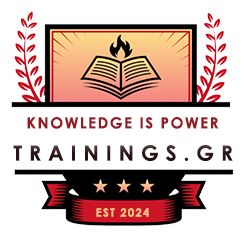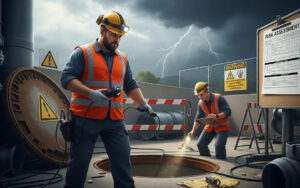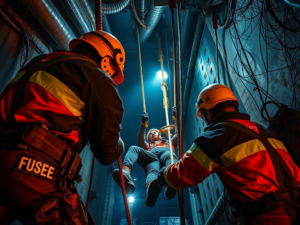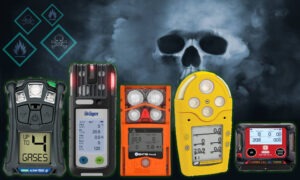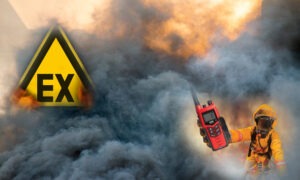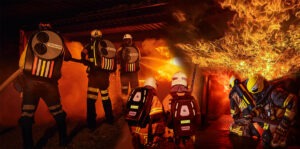
By John S. Retsios
(The previus article, Part IΙ you can read here)
New generation Full Face Masks
The newly developed communication systems optimally adapt to the design and ergonomics of the mask. Depending on what is required, it can be chosen with different modules and offers the optimal solution for each communication in the field. Whether radio, voice amplifier or head-up display, everything can be directly integrated into the mask and it is easy to use.
For missions requiring respiratory protection you have to expect extreme conditions: thick smoke and noise obstacles that not only cause stress but also significantly hinder any form of communication. This is even more difficult if a chemical protective suit is required: these suits restrict movement and suppress your voice.
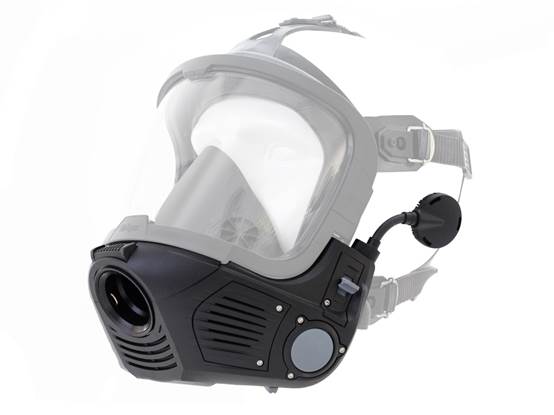
Each communication system (such as Drager FPS COM 7000) has an integrated PTT button (push-to-talk) to operate a radio that can be connected as an option. You can communicate using a tactical radio by pressing just one button. The tactical radio can be connected with a cable or Bluetooth. The latter means that there are no cables that could become entangled reducing the risk of snagging.
The communication system allows fast and efficient communication within one group or among different ones. And it works without pressing a single button. This improves your safety by not distracting you from your task. The voice-activated function also provides full-duplex communication. This means that you can talk and listen at the same time – as if you were on the phone. If there is only one radio for the entire group, the system allows the automatic transfer of the received instructions for up to ten group members via short-range radio. This means that only one member of the group needs a tactical radio while everyone is still informed immediately.
Hybrid Masks for CBRN
Hybrid Masks are engineered for ultimate protection in a variety of hazardous environments, reducing cost of ownership by supporting APR, PAPR and SCBA applications. High versatility supports CBRNE and long-duration missions The hybrid mask is ideal protection for personnel who face potential CBRNE operations or long-duration missions.
Based on newly designed systems can be used in three modes of operation with the same face piece: air purifying respirator (APR), powered air purifying respirator (PAPR), or self-contained breathing apparatus (SCBA). The mask works either in positive pressure mode as a SCBA or in normal pressure mode as an APR or PAPR. Switching between these modes is as simple as flipping a switch. The fact that can be used as a CBRN gas mask, CBRN PAPR, or a CBRN SCBA means that the user only has to carry a single mask. It also means less time required for pre-op preparation and gear maintenance. Additionally, it is only necessary to purchase one mask for three modes, rather than a separate mask for each mode. The hybrid mask has a triple sealed edge, as well as an impact-resistant lens which provides a field of vision that is greater than 90 percent for optimal situational awareness.

The system usually if required, offers a hydration device which can be connected to a canteen or a Camelback. An optional communication system, which has a microphone that is inserted into the mask, an ear speaker (or two) for clear reception of messages, and a push-to-talk button that is connected to the radio to ensure understanding of messages between teammates.
Gas Masks and filter cartridges
A full-face gas mask consists of a filter cartridge, flexible face covering piece, transparent eye lenses, and a series of straps and bands to hold the device snugly in place. The filter cartridge is a plastic canister 8-10 cm across and 2.5 cm deep, which contains a filtration aid. Carbon based filtrants are commonly used because they can adsorb large quantities of organic gases, especially high molecular weight vapors like those used in chemical warfare.
However, inorganic vapors are not usually strongly adsorbed on carbon. The adsorptive properties of carbon can be enhanced by impregnating the particles with specific reactants or decomposition catalysts. Such chemically treated carbon is known as “activated carbon.” The type of activated carbon employed in a given filter cartridge depends on the specific type of industrial contaminant to be screened. For example, carbon treated with a combination of chromium and copper, known as “Whetlerite carbon,” has been used since the 1940s to screen out hydrogen cyanide, cyanogen chloride, and formaldehyde. Today, due to concerns about chromium toxicity, a combination of molybdenum and triethylenediamine is used instead.

Other types of activated carbon employ silver or oxides of iron and zinc to trap contaminants. Sodium-, potassium- and alkali-treated carbon are used to absorb sewage vapors (hydrogen sulfide), chlorine, and other harmful gases.
The face-covering piece, of the mask is used to hold the other components in place and to provide a secure seal around the face area. Depending upon mask design, an exhalation valve may be inserted in the face piece. This one-way valve allows exhaust gases to be expelled without allowing outside air into the mask.
The eyepieces used in gas masks are chemically resistant, clear plastic lenses. Their main function is to ensure the wearer’s vision is not compromised. Depending on the tactical environment in which the mask is to be used, the eyepieces may have to be specially treated to be shatterproof, fog resistant, or to screen out certain types of light (laser beam etc.). The elastic straps that hold the mask on the face are typically made of silicone rubber, EPDM or other suitable material. Supplementary straps (neck strap) may be added to allow the mask to be comfortably hung around the neck during breaks at work.
Chemical Filters
Chemical filters are used on respirators to help remove and lower worker exposures to harmful gases and vapours in the workplace.
There are several types of chemical filters:
- Organic vapour.
- lnorganic vapour.
- Acid gases.
- Ammonia
- Formaldehyde
- Merculy vapour.

Cleaning & Disinfection for PPE
In this chapter we will present only the methods for cleaning since disinfection is a procedure which needs practical experience and the user must be trained by an instructor for this purpose.
Procedure for Cleaning your Mask
- Remove filters, cartridges, or canisters. Disassemble facepieces by removing speaking diaphragms, lung demand and pressure- demand valve assemblies, hoses, or any components recommended by the manufacturer. Discard or repair any defective parts.
- Wash components in warm (30 deg.maximum) water with a mild detergent or with a cleaner recommended by the manufacturer. (e.g., Sekusept by Ecolab) A stiff bristle (not wire) brush may be used to facilitate the removal of dirt or a hard sponge.
- Rinse components thoroughly in clean, warm (30 deg. C maximum), preferably running water. Drain.
- When the cleaner used does not contain a disinfecting agent, respirator components should be immersed for two minutes in one of the following:
- Hypochlorite solution (50 ppm of chlorine) made by adding approximately one milliliter of laundry bleach to one liter of water at 30 deg. C or ,
- other commercially available cleansers of equivalent disinfectant quality when used as directed, if their use is recommended or approved by the respirator manufacturer.
- Rinse components thoroughly in clean, warm (30 deg.C maximum), preferably running water. Drain. The importance of thorough rinsing cannot be overemphasized. Detergents or disinfectants that dry on facepieces may result in dermatitis. In addition, some disinfectants may cause deterioration of rubber or corrosion of metal parts if not completely removed.
- Components should be hand-dried with a clean lint-free cloth or air-dried.(not high pressure)
- Reassemble facepiece, replacing filters, cartridges, and canisters where necessary.
- Test the respirator with an appropriate testing device for leakages to ensure that all components work properly.

Maintainance and cleaning of your Chemical Protective Suit
Due to the vast number of chemicals and their different properties, no general decontamination procedure exists. The best way to decontaminate must be decided for the specific chemical encountered. This decision may only be taken by people educated for this task and with good knowledge of chemistry. Different CPS manufacturers may be contacted for advice.
As a first rule a pre-decontamination must always be performed before doffing the suit – the safety of the wearer is the most important! This predecontamination should include rinsing with large amounts of water, if possible, containing a detergent.
After this initial procedure the real decontamination can take place and since all chemicals can be divided into groups, depending on chemical and/or physical properties, the following three groups are the most relevant when it comes to decontamination:
- Volatile
- Soluble or reacts with water
- Insoluble in water
NOTE: There are many effective cleaning and decontamination agents available on the market. However, some of them contains corrosive chemicals which may affect the suit materials or components after long time use or repeated use. Therefore, if you are unsure, always contact CPS manufacturer for advice before use.
VOLATILE CHEMICALS
Chemicals that have lower boiling temperature than 80 °C are regarded as volatile. These are typically solvents like ethyl acetate, heptane, benzene, chloroform, acetone, and many others.To decontaminate a suit which has been in contact with a volatile compound you air the suit outdoors or in a well-ventilated area, if possible, at a slightly elevated temperature (30-40 °C).
Hang the suit with the zipper fully open and enough space around it, so that the air can flow freely around the suit. The required time for ventilating the chemicals depends on the temperature and airflow rate around the suit. After having aired the suit check for odour/smell of the chemicals and test the air for residual chemicals by using simple gas detecting tubes.
WATER SOLUBLE CHEMICALS
Chemicals that have higher solubility than 60 g/l water are regarded as water soluble. Also, the solubility is dependent on the temperature; an increase in temperature increases the solubility. Examples of water-soluble chemicals are: phenol, ethylene glycol, sodium, all acids and alkali.When decontaminating a suit which has been in contact with a water-soluble compound you rinse the suit thoroughly with water, preferably with some added detergent. To further enhance the solubility, you can use warm water (30 °C).
Acids and alkali
Examples: sulphuric acid, hydrochloric acid, sodium hydroxide, ammonium hydroxide.
Since both acids and alkali are soluble in water, a suit which has been in contact with either one of them should be rinsed with water. Residual acid may first be neutralised with a dilute solution of alkali and vice versa for residual alkali. Afterwards, rinse thoroughly with water with some added detergent. The pH should be checked during the decontamination, when the pH is neutral the decontamination is finished. pH can easily be checked with a pH-stick.
WATER INSOLUBLE CHEMICALS
Chemicals that are not water soluble are soluble in some type of solvent, for example alcohol or white spirit. Chemicals that have lower solubility than 60 g/l water are regarded as water insoluble.Examples are: styrene, pyridine, nitrobenzene, diesel and crude oil.
If the suit has been in contact with a water insoluble compound you wipe the suit thoroughly with a cloth soaked in alcohol or white spirit (depending on what solvent will solve the chemical). Afterwards, rinse thoroughly with water with some added detergent.
There are chemicals that are so sticky that it is more or less impossible to get the suit completely clean. If this occurs the suit must be scrapped.
CHEMICAL WARFARE AGENTS
To decontaminate chemical – and also biological – warfare agents it is recommended using a 30% water slurry of calcium hypochlorite (also known as chloride of lime or HTH). The suit is washed with the slurry and the slurry is allowed to react with the agents for about 15 minutes before it is washed off with water. After this procedure the suit is washed thoroughly with lots of water, preferably with some added detergent.
Once again if you are unsure, always contact CPS manufacturer for advice before use.
Zipper Special Caution
DYNAT-slide fasteners are hermetically sealed and used as conventional zippers.
They are used wherever people need to be safeguarded by special protective clothing against unfavourable or even harmful factors in their environment, i.e. in the fields of chemical protection, diving, surface watersport, survival and offshore-industry as well as for technical applications like special packaging’s.
The fastener system has been developed especially for the chemical protective suits. Generally, the additional seals make mobility more difficult in comparison to zip fasteners on normal clothing. To prevent folds forming on the fastener system, the open section of the fastener system must be free of tension and operated without being twisted. At the same time, the closed area must be held tight with the hand. The protective suit wearer should be standing upright when opening and closing the fastener system.
To avoid damage to the fastener system, both halves of the zip must be parallel and unstressed. Do not use force when opening and closing the fastener system or jerk the zipper. Fastener systems without sufficient lubrication are more difficult to operate. This can result in damage to the fastener system. Lubricate the fastener system using the grease stick supplied by your manufacturer.
Opening the fastener system
- Fully open the fastener system.
- Always pull the zipper tab in the direction of the zipper mechanism, never pull diagonally!
- Do not use force. Zip elements can become bent!
- If the zipper tab gets caught, pull it back and push it forward again.
Closing the fastener system
- When closing the fastener system, avoid diagonal forces on the zip.
- Pull the fastener chains together by hand.
- Then the zip will slide more easily along the section that is being pulled together.
- Foreign objects, such as shirt, jacket, threads, etc. must not be trapped between the zip elements.
Don’t forget to maintain your zipper with the special grease from DYNAT.
Testing Devices for PPE
There are several different devices for testing PPE some of them are directly from the manufacturer of the product others from independent laboratories.
With these devices you can test for leakages, low pressure tests etc. It is really important after each cleaning of your mask or your suit to test it according to the guidelines of the manufacturer. Usually, the test devices do not occupy much space and can be integrated smoothly into your workshop.
It is strongly recommended that the users of the testing devices should be fully trained from the manufacturer understanding the parameters of each PPE and the tolerances of each test.


Testing possibilities
- Full face masks
- Lung demand valves
- Pressure reducer (medium pressure function)
- Compressed air breathing apparatus
- Chemical protection suits
International & European Regulations
Depending on where they are sold, chemical protective suits must comply with specific regional standards that ensure they meet stringent performance requirements. For example, EN certification is required in Europe, while NFPA is the primary certification standard for protective suits and equipment in the United States and Canada. To meet these standards, protective suits and equipment are exposed to harsh conditions simulating the actual threats responders might face in the field, such as extreme temperatures, chemical exposure, and abrasion.
While both EN and NFPA standards provide a guaranteed level of safety and performance, it is important to note they are not the same. Each certification requires different testing procedures, each with its own methodology to simulate real-life hazmat incidents. In order to ensure they procure the best equipment for their emergency response teams, it is essential that organizations and companies understand the two main international certifications in hazmat suits, EN 943 and NFPA 1991, as well as the differences between them, including the tests performed and minimum performance requirements.
Chemical protective suits (CPS) are essential for CBRN severe situations while working with unknown and dangerous chemicals and substances as well as during decontamination. The new gas-tight CPS are especially designed for assignments under these extreme conditions. The suit material offers comprehensive protection from a wide variety of toxic industrial chemicals, chemical agents und biological hazardous substances liquefied gasses, and bursts of flames.
New suit materials protects during work in potentially explosive atmospheres as well as with the handling of frozen substances and hazardous substances at temperatures down to – 80°C. The suit even retains its protective effect if the surface is damaged. Material combinations of a double-sided sturdy elastomer layer and chemically resistant laminate layer plus a tear proof textile ensures this.
Exceeds international standards
Numerous international and national standards, for example the European EN 943-2, the EN 1073-2 and the British CBRN Standard BS 8467 specify the safety standards for chemical protection suits. Due to the new textile materials, CPS not only meets all the specified standards for reusable protection suits, but also exceeds the requirements for emergency teams and CBRN-Units from fire services, civil defense, and civil protection as well as the military.
Regulations regarding breathing protection
- EN 137:2006 type 2 (Self Contained Breathing Apparatus)
- EN 136 class 3 (Full face masks)
- BS 8468-1:2020 Respiratory protective devices for use against chemical, biological, radiological and nuclear (CBRN) agents Positive pressure, self-contained, open-circuit breathing apparatus.
- BS 8468-2:2020 Respiratory protective devices for use against chemical, biological, radiological and nuclear (CBRN) agents Negative pressure, air purifying devices with full face mask.
- EN 529:2006 Respiratory Protective Devices
- EN 12245:2022 Transportable gas cylinders – Fully wrapped composite cylinders
- EN 12021:2014 Respiratory protective devices – Compressed gases for breathing apparatus
- 2014/68/EU Pressure Equipment
- EN 14593-1:2018 – Respiratory protective devices – Compressed air line breathing devices with demand valve – Part 1: Devices with a full-face mask – Requirements, testing and marking
- EN 14594:2018 – Respiratory protective devices – Continuous flow compressed air line breathing devices – Requirements, testing and marking
Regulations regarding body protection
- EN 943-1:2015+A1:2019 – Protective clothing against dangerous solid, liquid and gaseous chemicals, including liquid and solid aerosols – Part 1: Performance requirements for Type 1 (gas-tight) chemical protective suits
- EN 943-2:2019 – Protective clothing against dangerous solid, liquid and gaseous chemicals, including liquid and solid aerosols – Part 2: Performance requirements for Type 1 (gas-tight) chemical protective suits for emergency teams (ET)
- EN 1073-1:2016+A1:2018 – Protective clothing against solid airborne particles including radioactive contamination – Part 1: Requirements and test methods for compressed air line ventilated protective clothing, protecting the body and the respiratory tract
- EN 1073-2:2002 – Protective clothing against radioactive contamination – Part 2: Requirements and test methods for non-ventilated protective clothing against particulate radioactive contamination
- EN 14605:2005+A1:2009 – Protective clothing against liquid chemicals – performance requirements for clothing with liquid-tight (Type 3) or spray-tight (Type 4) connections, including items providing protection to parts of the body only (Types PB [3] and PB [4])
- EN 14126:2003 – Protective clothing – Performance requirements and tests methods for protective clothing against infective agents
- EN 1149-5:2018 – Protective clothing – Electrostatic properties – Part 5: Material performance and design requirements
- ISO 16602:2007 – Protective clothing for protection against chemicals — Classification, labelling and performance requirements
Important issue for PPE products
Sometimes users are combining parts from different manufactures in order to cover the lack of one component e.g., Lung demand valve. You must be careful since each part component carries a unique certification, and the total amount of products create a new certification which is valid only if they are coming from the same manufacturer – brand name.
In case of an accident, you will find yourself in lot of troubles if you have made a puzzle SCBA from different manufacturers since there will be no certification for the overall SCBA.
Epilogue
Closing this article, I would like to thank all my instructors, my students and the people who never believed in me, for the valuable information’s and experiences provided me in my career.
And don’t forget, our greatest glory is not in never falling, but in rising every time we fall…
John S. Retsios
*Mr. John Retsios is a professional trainer for HazMat and CBRNE PPE with an experience of more than 20 years in the field.
Bibliography
- Ahmstead, B.H. Manufacturing Processes. John Wiley and Sons, 1977
- How to choose the right PPE James P. Zeigler Ph.D.2007
- S. Department of Health and Human Services
- The National Personal Protective Technology Laboratory (NPPTL)
- DelValle Institute & Learning Center
- Grainger Institution for Safety
- Understanding EN and NFPA Standards for Chemical Protective Suits, Ian Hutcheson, 2012
- Protective clothing against chemical and biological hazards, Erja Mäkelä, Helena Mäkinen, Finnish Institute of Occupational Health
- Ansell S.
- Drägerwerk AG & Co. KGaA
- MSA the Safety Company
- Respirex International Ltd
- TESIMAX – Altinger GmbH
- DYNAT Verschlußtechnik GmbH
Acronyms
- CBRNE : Chemical Biological Radiological Nuclear and Explosive
- PAPR : Powered Air Purifying Respirator
- SCBA : Self-Contained Breathing Apparatus
- CCBA : Closed Circuit Breathing Apparatus
- LDV : Lund Demand Valve
- CPS : Chemical Protective Suit

